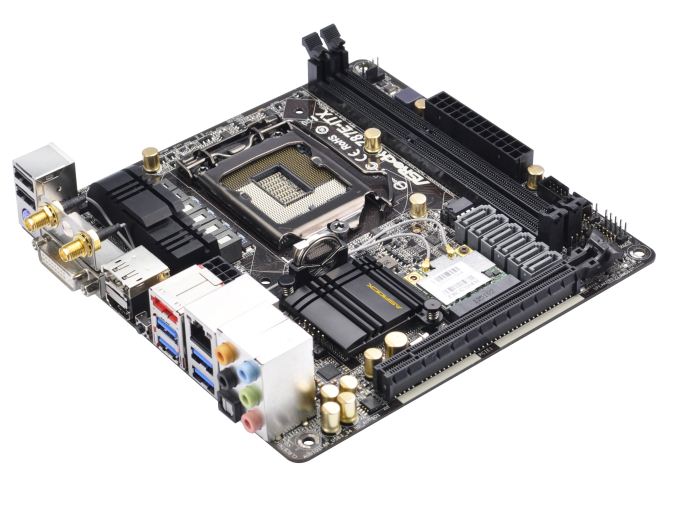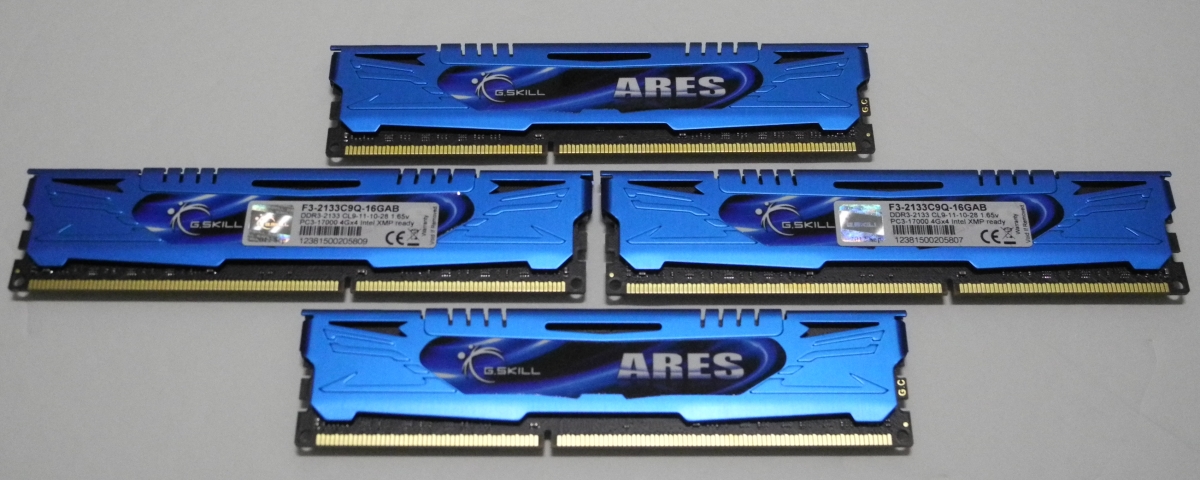Intel's Haswell - An HTPC Perspective: Media Playback, 4K and QuickSync Evaluated
by Ganesh T S on June 2, 2013 8:15 PM ESTTestbed and Software Setup
Instead of going for the usual high end CPU (77W / 95W TDPs), we have opted for the Core i7-4765T for today's review. This is a 35W TDP CPU with four cores / eight threads, expected to retail with a MSRP of $303. Intel has a number of GPU configurations doing the rounds at Haswell launch. The i7-4765T sports the HD 4600 GPU, and it is the best GPU available in a LGA 1150 configuration (The Iris Pro 5200 GPUs are reserved for BGA configurations and unavailable to system builders).
The table below presents the hardware components of our Haswell HTPC testbed
| Haswell HTPC Testbed Setup | |
| Processor | Intel Core i7-4765T - 2.00 GHz (Turbo to 3.0 GHz) |
| Intel HD Graphics HD4600 - Up to 1200 MHz | |
| Motherboard | ASRock Z87E-ITX mITX |
| OS Drive | Seagate 600 SSD ST240HM000 240GB |
| Memory | G.SKILL Ares Series 8GB (2 x 4GB) SDRAM DDR3 2133 (PC3 17000) F3-2133C9Q-16GAB CAS 9-11 -10-28 2N |
| Optical Drive | ASUS 8X Blu-ray Drive Model BC-08B1ST |
| Case | Antec Skeleton ATX Open Air Case |
| Power Supply | Antec VP-450 450W ATX |
| Operating System | Windows 8 Professional x64 |
| Displays / AVRs | Onkyo TX-SR606 + Acer H243H |
| Pioneer Elite VSX-32 + Sony Bravia KDL46EX720 | |
| Sony XBR-84X900 | |
| Seiki Digital SE50UY04 | |
The ASRock Z87E-ITX board comes with a Broadcom-based 802.11ac 2T2R solution. Connected to a Buffalo WZR-D1800H 802.11ac router, I was able to consistently obtain 173 Mbps of practical throughput. Streaming Blu-ray ISOs over Wi-Fi from a NAS worked without issues. The board was very simple to get up and running and given its form factor and the CPU currently installed, I hope to migrate it to a passive HTPC build soon.
The Haswell platform officially supports DDR3-1600. Towards this, we obtained a 16 GB DDR3-2133 Ares kit from G.Skill for our testbed. The Ares kit supports XMP 1.2 and the ASRock Z87E-ITX had it running at 2133 MHz flawlessly on first boot. However, we made sure to run the memory at the suggested 1600 MHz in order to obtain results consistent with what an average system builder (non-overclocker) would obtain. The Ares kit makes it possible to study HTPC behaviour from a memory bandwidth perspective, but we will not cover that aspect in this launch piece.
The software setup for the Haswell HTPC testbed involved the following:
| Haswell HTPC Testbed Software Setup | |
| Intel Graphics Driver | 9.18.10.3107 (Version on ASRock Motherboard DVD) |
| Blu-ray Playback Software | CyberLink PowerDVD 13 |
| Media Player | MPC-HC v1.6.7.7114 |
| Splitter / Decoder | LAV Filters 0.57 |
| Renderers | EVR / EVR-CP (integrated in MPC-HC v1.6.7.7114) |
| madVR v0.86.1 | |
The madVR renderer settings were fixed as below for testing purposes:
- Decoding features disabled
-
Deinterlacing set to:
- automatically activated when needed (activate when in doubt)
- automatic source type detection (i.e, disable automatic source type detection is left unchecked)
- only look at pixels in the frame center
-
Scaling algorithms were set as below:
- Chroma upscaling set to SoftCubic with softness of 100
- Luma upscaling set to Lanczos with 4 taps with anti-ringing filter left deactivated and scale in linear light left unchecked / DXVA2
- Luma downscaling set to Lanczos with 4 taps with anti-ringing filter left deactivated and scale in linear light left unchecked / DXVA2
-
Rendering parameters were set as below:
- Automatic fullscreen exclusive mode was used
- CPU and GPU queue sizes were set to 32 and 24 respectively
- Under exclusive mode settings, the seek bar was enabled, switch to exclusive mode from windowed mode was delayed by 3 seconds and 16 frames were configured to be presented in advance. The GPU flushing modes were set to default
- Smooth motion was left disabled
- The 'trade quality for performance' settings were left at default (i.e, linear light was left disabled for smooth motion frame blending and custom pixel shader results were stored in 16-bit buffers instead of 32-bit)
Unlike our Ivy Bridge setup, we found the windowed mode to be generally bad in terms of performance compared to exclusive mode.
MPC-HC and LAV Filters settings were altered from the defaults as below for testing purposes:
- DirectShow Video Output was configured as EVR / EVR-CP / madVR under Options > Playback > Output
- All internal source and transform filters were disabled under Options > Internal Filters
- Under Options > External Filters, LAV Splitter, LAV Audio Decoder and LAV Video Decoder were added as Preferred filters
- LAV Audio Decoder was set to bitstream all applicable formats
-
LAV Video Decoder were altered from the defaults as below
- Hardware Acceleration was set to DXVA2 Native / QuickSync / None depending on the aspect being tested. UHD (4K) was enabled in all the cases
- Deinterlacing mode was set to 'Aggressive'












95 Comments
View All Comments
meacupla - Monday, June 3, 2013 - link
there's like... exactly one mITX FM2 mobo even worth considering out of a grand total of two. One of them catches on fire and neither of them have bluetooth or wifi.LGA1155 and LGA1150 have at least four each.
TomWomack - Monday, June 3, 2013 - link
The mITX FM2 motherboard that I bought last week has bluetooth and wifi; they're slightly kludged in (they are USB modules apparently glued into extra USB ports that they've added), but I don't care.The Haswell mITX boards aren't available from my preferred supplier yet, so I've gone for micro-ATX for that machine.
BMNify - Monday, June 3, 2013 - link
I know you're trolling but the fact is more people are content with converting their 5 year old C2D cookie cutter desktop into an HTPC ($50 video card + case + IR receiver = job done) than buying all new kit.We reached the age of "good enough" years ago. Money is tight and with all the available gadgets on the market (and more to come) people are looking to make it go as far as possible. Intel is going to find it harder and harder to get their high margin silicon into the homes of the average family. Good enough ARM mobile + good enough x86 allows people to own more devices and still pay the bills. It looks like AMD has accepted this, they've taking their lumps and are moving forward in this "new world". I'm not sure what Intels long term strategy is but I'm a bit concerned.
Veroxious - Tuesday, June 4, 2013 - link
Agreed 100%. I am using an old Dell SFF with an E2140 LGA775 CPU running XBMCbuntu. It works like a charm. I can watch movies while simultaneously adding content. That PC is near silent. What incentive do I have for upgrading to a Haswell based system? None whatsoever.kallogan - Monday, June 3, 2013 - link
2.0 ghz seriously ??? The core 45W Sandy i5-2500T was at 2,3 ghz and 3,3 ghz turbo. LOL at this useless cpu gen.kallogan - Monday, June 3, 2013 - link
Forget my comment didn't see it was a i7 with 8 threads. 35W tdp is not bad either. But the 45W core i7-3770T would still smoke this.Montago - Monday, June 3, 2013 - link
I must be blind... i don't see the regression you are talking about.HD4000 QSV usually get smudgy and blocky.. and that i don't see in HD4600 ... so i think you are wrong in your statements.
comparing the frames, there is little difference, and none i would ever notice while watching the movie on a handheld device like an tablet or Smartphone.
The biggest problem with QSV is not the quality, but the filesize :-(
QSV is usually 2x larger than x264
ganeshts - Monday, June 3, 2013 - link
Montago,Just one example of the many that can be unearthed from the galleries:
Look at Frame 4 in the 720p encodes in full size here:
HD4600: http://images.anandtech.com/galleries/2836/QSV-720...
HD4000: http://images.anandtech.com/galleries/2839/QSV-HD4...
Look at the horns of the cattle in the background to the right of the horse. The HD4000 version is sharper and more faithful to the original compared to the HD4600 version, even though the target bitrate is the same.
In general, when looking at the video being played back, these differences added up to a very evident quality loss.
Objectively, even the FPS took a beating with the HD4600 compared to the HD4000. There is some driver issue managing the new QuickSync Haswell modes definitely.
nevcairiel - Monday, June 3, 2013 - link
The main Haswell performance test from Anand at least showed improved QuickSync performance over Ivy, as well as something called the "Better Quality" mode (which was slower than Ivy, but never specified what it really meant)ganeshts - Monday, June 3, 2013 - link
Anand used MediaEspresso (CyberLink's commercial app), while I used HandBrake. As far as I remember, MediaEspresso doesn't allow specification of target bitrate (at least from the time that I used it a year or so back), just better quality or better performance. Handbrake allows setting of target bitrate, so the modes that are being used by the Handbrake app might be completely different from those used by MediaEspresso.As we theorize, some new Haswell modes which are probably not being used by MediaEspresso are making the transcodes longer and worse quality.